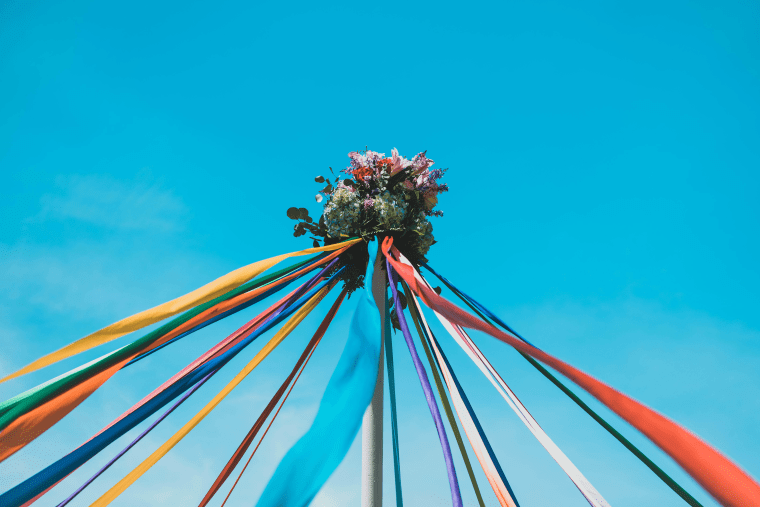When Suzanne Robotti, president of MedShadow Foundation, was in elementary school, her family had a neighbor who kept a beautiful garden. “We used to walk around as she taught me the names of the flowers,” Robotti recalled. “Her favorite holiday was May Day, and she talked about festivals in her hometown with a Maypole,” she added of her neighbor, who was a Jewish refugee from Germany during World War II.
When Robbotti moved into an apartment with a terrace just over a decade ago, she realized she could honor her gardening pal of yesteryear by creating a May Day festival for her own. It’s been a beloved tradition — and quite the party, complete with spring cuisine, tasty drinks, and verdant views — ever since.
Robotti isn't alone in her love of May Day. On May 1, countless people around the world celebrate the spring holiday, one that marks roughly the halfway point between the Northern Hemisphere’s Spring equinox and the summer solstice in June. A spring festival of sorts, May Day events can include flower crowns, arts and crafts projects, picnics, maypole dancing, community gatherings and more.
FYI: May Day also falls on the same day that International Workers’ Day is recognized in honor of the contributions of laborers, though the holidays are unrelated. Also known as “Labour Day,” around the globe, this holiday is a significant one, but not celebrated in the U.S.
Interestingly, the spring festival holiday actually has its origins in paganism, a fact that is unbeknownst to many raising a glass on May 1. Before you start twirling around the maypole, keep reading to learn about May Day’s pagan roots and why and how May Day is celebrated.
What is the history of May Day?
Instead of uttering the superstitious expression “rabbit rabbit” to start a new month, you may have kicked things off this month with another short expression: Happy May Day!
In modern times, you might think of May Day as an excuse to sport a floral crown, but the tradition actually dates back to ancient times. “In Pre-Christian history, May Day is the celebration of Spring into Summer, and as a lot of pagan history revolves around the seasons, nature and how it is reflected from agriculture into us as humans, too,” Lizzie Burgess, tarot reader and astrologist at Backyard Banshee, based in Cheshire, UK, tells TODAY.com.
As the flowers burst and fruits begin to bloom, so does our natural instinct to get out there and celebrate life, she continues, noting that pagans refer to those who don’t follow Christianity, Judaism or Catholicism.
Across Europe, Burgess shares that the shift in seasons was traditionally celebrated under many names such as Walpurgisnacht, Vuppa or Bealtaine, when farmers would take horses and livestock out to pastures from their winter stables, communities would gather to “scare away demons and devils” and community members would all light bonfires and make noise to protect themselves. The tradition of handfastings (typically, when people were married in an officiated wedding) and weddings would start to take place around now, says Burgess, “so it’s perfect for honeymoon season, and May flowers such as hawthorn blossom and primrose would adorn houses for additional protection.” This protection was said to ward off evil spirits and bad intentions from neighbors and/or neighboring towns. “And even the Fae,” adds Burgess, who are notorious for stealing dairy products and cows, which were the livelihood of many farms.
How did the Maypole come to be for May Day celebrations?
Maypole dancing is a much-loved tradition of the May Day holiday. Basically, you get dressed up in colorful clothing and dance around a tall pole decorated with flowers and ribbons (you hold onto the ribbons while you move about to create notable patterns!). Music and singing often go hand in hand with this activity.
But how did Maypoles come to be associated with May Day? As Burgess explains, these spring festivals were traditionally a time when trees were decorated. “It’s not just Yule & Christmas that get this treatment,” she says. “This tree decorating (and dancing/partying around for the towns and villages) then led to what we now see is an interpretation of a Maypole.”
Sometimes, bonfires take place at modern-day May Day festivals, and again, this is connected to May Day’s pagan origins. “Neopagans, Reconstructionists and Wiccans love to celebrate Beltane through bonfires, getting together to celebrate each other, and to prep for the season of work ahead,” comments Burgess.
How to celebrate May Day
To host a May Day celebration solo or with your nearest and dearest, Burgess shares the following ideas. Remember, these are just starting points. Get creative and do what feels most authentic to you as a way to mark the changing of the seasons and your respect and awe for nature.
Paint a candle with things you like to see prosper.
It’s such a nice thing to do for decor anyway, but if you’re aligning intentions with manifestation work it’s a quick and easy way to go about it. You can choose to light it, or keep it out for six months until Halloween/Samhain, when it’s known to be summer’s end.
If you can get out into nature, see the sunset or the following sunrise.
Enjoy your morning hot coffee in its warmth, or have some relaxing tea. Relish in being barefoot, even if it’s still cold.
Jot down a gratitude list.
Take time to list five things you are immediately grateful for, especially within your community, and see what a difference this makes to your day.
Eat, drink and be merry.
Delight in foods like light salads and breads; bake something for yourself, or share a meal with a loved one spontaneously.
Show up and be present for one another.
Listen if any anxieties or worries are lingering for each of you, so that you can unanimously fight against the dark together.
The bottom line: “You don’t need to go dancing around any poles, but if you find yourself with time with little ones and want to create a cute daisy chain (or dandelion crown) then why not hang it on your nearest tree?” says Burgess. “And a little glass of milk for the Fae can never hurt.”
Why celebrate May Day?
For one thing, any excuse to gather with loved ones and party is a good one. For many, though, May Day symbolizes the opportunity to recognize life’s ephemeral nature and be grateful for our time passing through it all. “The May Day flames of life remind us all that yes, we are alive,” says Burgess. “And we made it through winter and spring to get here to summer.”











